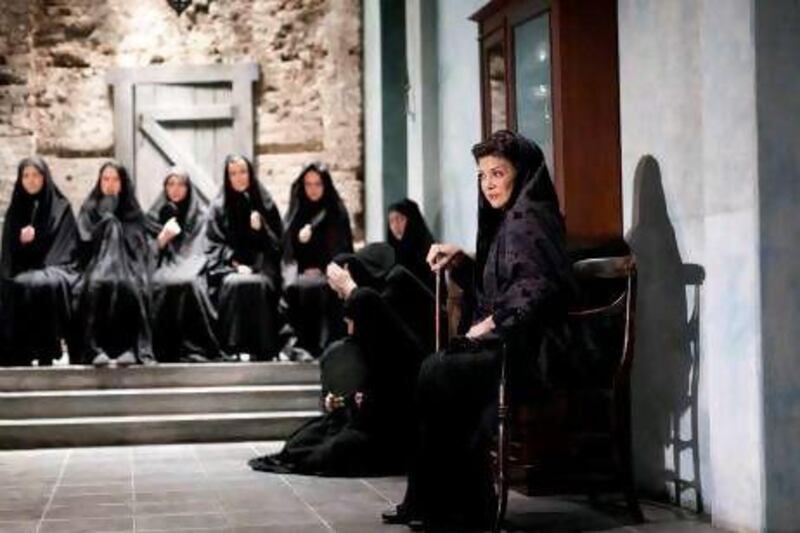Federico García Lorca's The House of Bernarda Alba, currently showing at London's Almeida Theatre, is a study of the effects of matriarchal oppression. After the death of her second husband, Bernarda imposes an eight-year mourning period, forcing all five of her daughters into black and curtailing their already limited freedoms. The eldest is being courted by a young man from the village, but Bernarda is determined to keep the rest under lock and key. It is the desire and defiance of the youngest daughter, Adela, that precipitates catastrophe.
The Oscar-nominated Iranian actress Shohreh Aghdashloo, buttoned to the neck in a rich, dark dress, gives us a Bernarda who is a tyrant but not a monster. Here as elsewhere, the production shies away from easy contrasts and simplistic moral absolutes. Bernarda is full of contradictions, and Aghdashloo’s sultry voice and glamorous features belie the iron hand with which she rules the house. We sense flashes of the very passion she seeks to eradicate in her daughters. Her ever-present walking-stick is both an instrument of discipline and a means of support.
From the opening altercation between Jane Bertish’s wry housekeeper Darya and a particularly stubborn vacuum cleaner, this is a relentlessly domestic play. Lorca’s plot, with its enclosed setting and all-female cast, has a chamber quality that builds emotional pressure to a tragic release – taking us, the captive audience for 100 minutes without interval – with it. We are in the room with the daughters, prisoners like them, yearning for them to be free.
Perhaps it is this quality of isolation and interiority that allows the bold relocation of the play to rural Iran. “We found there were many things that simply didn’t need changing,” says the director Bijan Sheibani, himself half Iranian. “You have to be careful moving a play from the time and place it’s set in. It’s a bit like uprooting a tree with complicated roots.” But Lorca seems to flourish in the soil of the Middle East – from the laws and honour codes to the potential of language with “?‘Allah’ and ‘olé’ coming from the same root”, and the blazing heat outside, the translation is striking but somehow right.
The political implications never feel crude or forced, perhaps because they are never foregrounded. Like the invisible disapproval of society at large and the dashing lover who drives the play without ever once appearing, they are kept forever just offstage, heard through the walls but never seen.
“We weren’t trying to say something about Iran by setting the play there,” explains Sheibani. “In terms of gender politics and unrest, we found resonances between Spain and Iran during rehearsals, but the play could be set in Britain if you wanted it to be. These problems could occur anywhere.”
The tragedy of the play is the collision between the individual’s desire for self-realisation and the strict, defensive honour codes of the family and of society. “As a play it works on many levels. It’s about a family, but that structure can also be applied on a political scale, as well as on the scale of the individual mind.”
Indeed, the dangers of repression and the anarchic tendency of passion to upset established hierarchies are psychological as well as political themes, and the production works to explore these on a symbolic level, as did Lorca’s original. Emily Mann’s translation takes a naturalistic approach to the dialogue while striving to retain the symbolic elements.
Of course, Lorca does a lot of the work himself; Adela’s act of rebellion is to wear a green dress and escape from the house each night in darkness. Even without the new-found significance of green in modern Iran giving this act resonance, the raw power of simply going out into the street is central to the iconography of the Arab Spring. Rebellion consists of escaping domesticity and participating in public life – something that Bernarda has tried to deny her children by keeping them in the prison of her house.
The design of this prison is restrained and elegant, eschewing the stark whites specified by Lorca for a more naturalistic, muted palette of ochre and black. Much thought has clearly gone into the spatial composition of the play – indeed, each scene opens and closes with a flash of light – at once the flashbulb of a family photo and the coup de foudre of Adela's illicit passion. Within each scene, elegant groupings and striking visual metaphors, like the gradual crowding in of the mourning women in their black chadors, creep up on the audience with the force of quiet surprise. It is this lightness of touch with which the play's big questions are handled that means they linger all the more in the minds of the audience upon their release.
The House of Bernarda Alba runs until March 10 at the Almeida in London. For tickets, see www.almeida.co.uk
Follow us on Twitter and keep up to date with the latest in arts and lifestyle news at twitter.com/LifeNationalUAE





